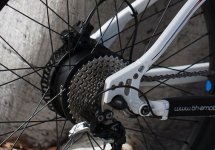Kepler
10 MW
Had the opportunity to ride another e-motion bike today at an EV expo. Got to say, the bike continues to impress. Some might be aware of the carbon frame Super commuter I built after my original test ride of a Jumper. http://endless-sphere.com/forums/viewtopic.php?f=6&t=47139 and i was keen to compare it to the e-motion. My bike runs a torque sensor and 750W. The e-motion torque sensor is so nice and responsive. Also the power of the e-motion feels more like my 750W then 250W. Shame about the 25 kph speed limiter.
Anyone who has bought one of these bikes should be well pleased with their purchase.
Anyone who has bought one of these bikes should be well pleased with their purchase.



